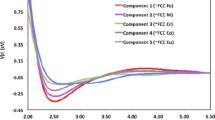Abstract
Using the К(Н/D)2РО4 ferroelectrics as an example, a simplified quantum-chemical approach to the description of the structural phase transition driven by an increase in the number of H/D-bonds in model clusters has been proposed and substantiated. In this case, the simplified description takes into account only pseudospin configurations obeying the ice rule in the phase transition statistics. Calculations of various model systems have been used to test the efficiency of using an economical method for determining the Ising and Slater constants. The key results have been obtained within the framework of the standard Bethe approximation for trimeric clusters of two types (linear and corner), which differ significantly in symmetry from the lattice in various simulations of terminal H-bonds. There have been analyzed the advantages and disadvantages of the proposed approach for describing the transition thermodynamics and for the possibility of trial modeling of the structure of inhomogeneities associated with domain walls and their boundaries.




Similar content being viewed by others
REFERENCES
A. A. Levin and S. P. Dolin, J. Mol. Struct. 552, 39 (2000). https://doi.org/10.1016/S0022-2860(00)00457-9
S. P. Dolin, T. Yu. Mikhailova, N. N. Breslavskaya, et al., Int. J. Quantum Chem. 116, 202 (2016). https://doi.org/10.1002/qua.25037
S. P Dolin, T. Yu. Mikhailova, and N. N. Breslavskaya, Russ. J. Phys. Chem. A 88, 1872 (2014). https://doi.org/10.1134/S0036024414110065
A. A. Levin, S. P. Dolin, AND T. Yu. Mikhailova, Ros. Khim. Zhurn. 51, 139 (2007).
S. P. Dolin, T. Yu. Mikhailova, and N. N. Breslavskaya, Russ. J. Inorg. Chem. 65, 540 (2020). https://doi.org/10.1134/S0036023620040221
S. P. Dolin, T. Yu. Mikhailova, and N. N. Breslavskaya, Rus. J. Inorg. Chem. 65, 1015 (2020). https://doi.org/10.1134/S0036023620070050
S. P. Dolin, I. S. Flyagina, et al., Int. J. Quantum Chem. 107, 2409 (2007). https://doi.org/10.1002/qua.21406
R. J. Nelmes, Z. Tun, and W. F. Kuhs, Ferroelectrics 71, 125 (1987). https://doi.org/10.1080/00150198708224833
V. Ya. Shur, A. R. Akhmatkhanov, A. I. Lobov, and A. P. Turygin, J. Adv. Dielectr. 5, 1550015 (2015). https://doi.org/10.1142/S2010135X15500150
Y. Ishibashi, Ferroelectrics 98, 193 (1989).
A. A. Bullbich and Yu. M. Gufan, Ferroelectrics 98, 277 (1989).
N. A. Pertsev and G. Arlt, Ferroelectrics 132, 27 (1992).
V. Ya. Shur, J. Mater. Sci. 41, 199 (2006). https://doi.org/10.1007/s10853-005-6065-7
V. Ya. Shur, in Handbook of Advanced Dielectric, Piezoelectric and Ferroelectric Materials, (Elsevier, 2020). https://doi.org/10.1533/9781845694005.5.622
M. A. Moore and H. C. W. L. Willians, J. Phys. C 5, 3168 (1972).
T. Tentrup, K. H. Weyrich, and R. Siems, Jpn. J. Appl. Phys. 24, 571 (1985).
L. N. Kamysheva, V. N. Fedosov, and A. S. Sidorkin, Ferroelectrics 13, 463 (1976).
L. I. Stefanovich and O. Yu. Mazur, Formation of Domain Structures in Ferroelectrics under Highly Nonequilibrium Conditions Driven by External Factors (Serednyak T.K., Dnipro, 2019 [in Russian].
M. E. Lines and A. M. Glass, Principles and Applications of Ferroelectrics and Related Materials (Clarendon, 1977; Mir, Moscow, 1981).
V.G. Vaks, Introduction to the Microscopic Theory of Ferroelectrics (Fizmatlit, Moscow, 1973) [in Russian].
B. A. Strukov and A. P. Levanyuk, Physical Foundations of Ferroelectric Phenomena in Crystals (Nauka, Moscow, 1983) [in Russian].
R. Blinc and B. Žekš, Soft Modes in Ferroelectrics and Antiferroelectrics (North-Holland, Amsterdam, 1974; Mir, Moscow, 1975).
D. C. Mattis, The Theory of Magnetism (Harper & Row, New York, 1965; Mir, Moscow, 1967).
J. M. Ziman, Models of Disorder (Cambridge Univ. Press, 1979; Mir, Moscow, 1982).
L. Pauling, The Nature of the Chemical Bond (Cornell Univ. Press, New York, 1960).
A. S. Sidorkin, Domain Structure in Ferroelectrics and Related Materials (Fizmatlit, Moscow, 2000).
A. S. Sidorkin, Fiz. Tverd. Tela 31, 293 (1989).
J. Bornarel, Ferroelectrics 71, 255 (1987).
E. Z. Meilikhov and R. M. Farzetdinova, Phys. Rev. E 71, 046111 (2005). https://doi.org/10.1103/PhysRevE.71.046111
T. Yu. Mikhaylova, N. N. Breslavskaya, and S. P. Dolin, Russ. J. Inorg. Chem. 62, 935 (2017). https://doi.org/10.1134/S003602361707004X
T. Yu. Mikhaylova, N. N. Breslavskaya, and S. P. Dolin, Russ. J. Inorg. Chem. 63, 61 (2018). https://doi.org/10.1134/S0036023618010060
T. Yu. Mikhaylova, N. N. Breslavskaya, and S. P. Dolin, Russ. J. Inorg. Chem. 62, 1600 (2017). https://doi.org/10.1134/S0036023617120130
Funding
This work was supported by the Russian Foundation for Basic Research (project no. 19-03-00443) and was partially performed within the framework of the State assignment of the IGIC RAS (no. 44.2).
Author information
Authors and Affiliations
Corresponding author
Ethics declarations
The authors declare no conflict of interest.
Additional information
Translated by G. Kirakosyan
Rights and permissions
About this article
Cite this article
Dolin, S.P., Mikhaylova, T.Y. & Breslavskaya, N.N. Possibilities of a Simplified Approach to Studying the Features of Structural Phase Transitions in H-Bonded Ferroelectrics with the use of Ab Initio Calculations. Russ. J. Inorg. Chem. 66, 707–713 (2021). https://doi.org/10.1134/S0036023621050041
Received:
Revised:
Accepted:
Published:
Issue Date:
DOI: https://doi.org/10.1134/S0036023621050041




